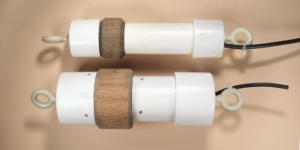The environmental conditions beneath an aboveground storage tank make it very difficult to obtain potential measurements. The sand is dry when the electrode is first installed. Cathodic protection currents and/or heat from the product further dries out the sand sharply increasing resistivity. A permanently installed reference electrode can completely dry out in this environment and the absence of moisture in the area will prevent it from rewetting. Consequently, electrodes in such locations may last only a few years. Where potential measurements throughout the life of an AST are desired, a preferred solution is to use Undertank Reference Electrode.
Model UT: Undertank Reference Electrode is placed in a slotted pipe installed in the sand pad beneath the tank bottom. When bottom potentials are needed, the electrode is slowly pulled through the pipe to produce a potential profile. Between measurements, the electrode can be either left at one end of the slotted pipe or used to develop a potential profile in another tank. Model UT Data Sheet

